I always wondered why my Tito Rolando's Relyenong Bangus was the most anticipated dish at every family reunion. One Wednesday afternoon, as I watched him carefully debone and stuff the milkfish in his tiny kitchen, he shared how his mother (my beloved Lola) taught him this recipe during the 1970s.
The patience required to prepare this dish reminds me of the Filipino value of "pagtitiis" - that truly special things take time and effort. While the process might seem daunting at first (yes, there's actual sewing involved!), I promise you the result is absolutely worth it.
After years of practicing Tito Rey's technique, I've finally mastered this classic relyenong bangus (Filipino stuffed milkfish) recipe that transforms an everyday bangus into a celebration-worthy centerpiece that never fails to impress my own dinner guests.
Jump to:

Why You'll Love This Recipe
- Perfect special occasion centerpiece dish
- Impressive presentation that wows guests
- Crispy exterior with flavorful, moist stuffing
- Can be prepared ahead
- Teaches valuable Filipino cooking techniques
- Combines traditional flavors with modern preparation methods
Ingredients
Each ingredient in this recipe serves a purpose. The onion and garlic create a savory base, while carrots and peas add color, texture, and nutrition. Raisins provide surprising bursts of sweetness that balance the savory fish. Oyster sauce delivers rich umami flavor without overpowering the delicate milkfish.
The egg binds everything together, and flour creates that perfect crispy exterior when fried. Together, they transform simple milkfish into an extraordinary dish with layers of flavor and texture.
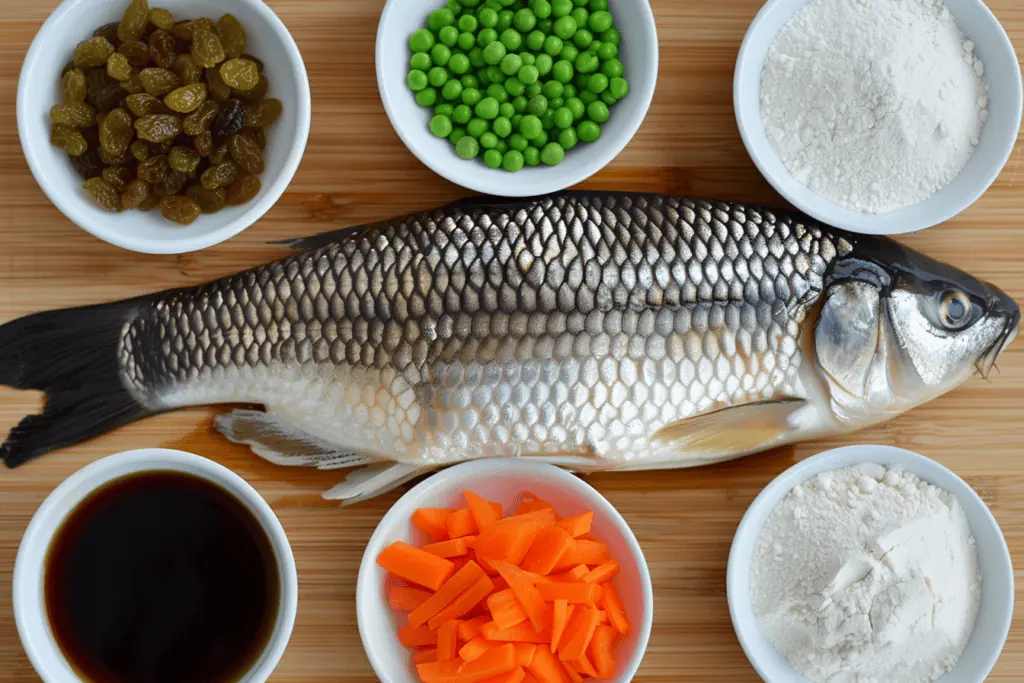
For the Fish:
- 1 large whole bangus (milkfish), about 1 kg
- Juice of 1 lemon
- 2 tablespoons soy sauce
- 1 cup water
- Oil for frying
For the Filling:
- 1 onion, finely chopped
- 2 garlic cloves, minced
- 1 large carrot, finely diced
- ½ cup green peas
- ¼ cup raisins
- 2 tablespoons oyster sauce
- Salt and pepper to taste
- 1 egg
- ½ cup all-purpose flour
Equipment
- Large, shallow pan for frying (kawali) - Ensures even cooking and browning of the stuffed fish
- Long, thin metal spatula (panghimay) - Essential for carefully separating the flesh from the skin during deboning
- Kitchen twine and needle - Necessary for sewing the fish closed after stuffing
- Sharp knife - For precise cuts during preparation
- Cutting board - Provides a stable surface for deboning and preparing ingredients
- Mixing bowls - For marinating the fish skin and mixing the filling
- Wooden spoon - Allows for gentle mixing without breaking up the fish flakes
- Strainer - Helpful for draining the boiled fish meat
- Paper towels - Removes excess oil after frying
- Meat thermometer (optional) - Ensures the fish is properly cooked to a safe temperature

How To Make
- Begin with fish preparation: Scale and clean the milkfish while keeping the belly intact. Break the spine near the tail and head to make deboning easier.
- Carefully debone the fish: Insert a spatula between the skin and flesh. Gently separate the meat from the skin working from the back toward the belly. Push the meat out through the neck opening. Clean the cavity thoroughly, ensuring no bones remain.
- Marinate cleaned fish skin: In a mixture of lemon juice and soy sauce for 30 minutes in the refrigerator at 4°C/40°F. This adds flavor and helps firm up the skin.
- Prepare filling:
- Boil fish meat in salted water at 100°C/212°F until fully cooked
- Flake and remove any remaining bones thoroughly
- Sauté onions and garlic over medium heat at 175°C/350°F until fragrant
- Add carrots, green peas, and raisins, cooking until vegetables soften
- Mix in oyster sauce and season with salt and pepper
- Cool the mixture completely before adding the beaten egg to bind
- Assemble and cook:
- Carefully stuff the fish skin with the prepared filling, distributing evenly
- Sew the openings closed with kitchen twine
- Dredge the stuffed fish in seasoned flour
- Fry at 175°C/350°F until golden brown on both sides
- Let rest 5-10 minutes before slicing to allow the filling to set
- Serving: Slice crosswise into serving portions and arrange on a platter with traditional accompaniments.

Tips from Lola's Kitchen
- Choose a fresh bangus that's at least 1 kg in weight for easier deboning and more meat
- Work slowly and carefully when deboning to keep the skin intact - patience is key!
- Keep a small bowl of water nearby to wet your fingers when handling the fish skin to prevent tearing
- Don't overstuff the fish - leave some room for the filling to expand during cooking
- Use fine kitchen twine for sewing - unflavored dental floss works in a pinch
- Test the oil temperature by dropping a small piece of filling - it should sizzle immediately
- Let the fish rest before cutting to help the filling set and make cleaner slices
- When deboning, start from the back of the fish rather than the belly for less chance of tearing
Substitutions
- Milkfish: Large mackerel or sea bass can work if bangus is unavailable
- Lemon: Calamansi, lime, or vinegar provide similar acidity
- Green peas: Sweet corn or finely diced bell peppers add color and sweetness
- Raisins: Chopped dried mangoes or apricots offer a Filipino-inspired twist
- Oyster sauce: Mix fish sauce with a pinch of sugar for a similar umami flavor
- All-purpose flour: Rice flour or cornstarch can be used for a gluten-free version
- Frying oil: Coconut oil adds a subtle tropical flavor that complements the fish
Troubleshooting
Skin tears during deboning:
- Patch small tears with a paste made from flour and water
- Work more slowly and carefully next time, keeping the skin moist
- Try partially freezing the fish (about 30 minutes) before deboning to firm it up
Filling falls apart:
- Ensure the mixture is completely cool before adding the egg binder
- Add an extra egg white if needed for more binding power
- Include a tablespoon of cornstarch in the mixture for additional structure
Fish browns too quickly during frying:
- Lower heat to medium and watch carefully
- Use deeper oil for more even cooking
- Consider par-frying, then finishing in a 350°F oven for 15 minutes
Filling is too dry:
- Add 2-3 tablespoons of mayonnaise to the mixture for moisture
- Include more vegetables with higher water content
- Don't overcook the fish meat before flaking
Difficulty sewing the fish closed:
- Use a larger needle with a wider eye
- Reinforce weak areas with additional stitches
- Pre-punch small holes along the seam with a toothpick
Storage & Reheating
Storage:
- Refrigerator: Store in an airtight container for up to 3 days
- Freezer: Wrap tightly in aluminum foil, then plastic wrap, and freeze for up to 2 months
- Note: For best results, freeze before frying, then thaw and fry when ready to serve
Reheating:
- Oven method (best): Preheat to 150°C/300°F, place on a baking sheet and heat for 15-20 minutes
- Pan method: Reheat on low heat with a cover to maintain moisture
- Avoid microwave reheating as it makes the exterior soggy
- Always ensure internal temperature reaches 63°C/145°F when reheating for food safety

FAQ
Can I prepare relyenong bangus in advance?
Yes, you can debone, stuff, and refrigerate the fish up to 24 hours before frying. This actually allows the flavors to meld better.
Why does the filling need to cool before adding the egg?
To prevent the egg from cooking prematurely, which would make it lumpy rather than acting as a binder.
Can I bake instead of fry the stuffed fish?
Yes, brush with oil and bake at 200°C/400°F for 25-30 minutes, turning halfway. The texture will be different but still delicious with less oil.
How do I know when the fish is fully cooked?
The internal temperature should reach 63°C/145°F, and the exterior should be golden brown and crispy.
Can I freeze the deboned fish skin before stuffing?
Yes, wrap well and freeze for up to 1 month. Thaw completely before stuffing.
What's the best way to serve leftover relyenong bangus?
Slice cold leftovers and serve over a salad, or flake and use in fried rice for a delicious next-day meal.
Can I use boneless bangus fillets instead?
Traditional relyenong bangus requires the whole fish skin intact, but you can adapt the recipe to make a roulade by flattening fillets, adding filling, rolling, and securing with toothpicks.
How do I prevent oil splatters when frying?
Ensure the fish is completely dry before frying, use a deep pan with high sides, and consider using a splatter screen.
Related
Looking for other recipes like this? Try these:
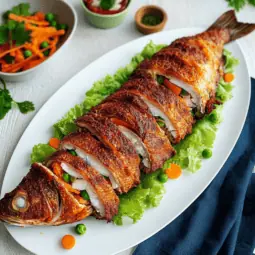
Relyenong Bangus (Filipino Stuffed Milkfish)
Equipment
- Large, shallow pan for frying (kawa/kawali) ensures even cooking
- Long, thin metal spatula (panghimay) for deboning
- Kitchen twine and needle (sinulid at karayom) for sewing the fish
- Sharp knife (kutsilyo) for precise cuts
- Cutting board (Tabla) for preparation
- Mixing bowls (mangkok) for marinating and mixing filling
- Wooden Spoon (Sandok Kahoy) for gentle mixing
- Strainer [Salaan] for draining
- Paper towels for removing excess oil
- Meat thermometer (optional) for ensuring proper cooking temperature
Ingredients
For the Fish:
- 1 large whole bangus milkfish, about 1 kg
- Juice of 1 lemon kalamansi can be substituted
- 2 tablespoons toyo soy sauce
- 1 cup tubig water
- Oil for frying
For the Filling:
- 1 sibuyas onion, finely chopped
- 2 bawang garlic cloves, minced
- 1 large carrot carrot, finely diced
- ½ cup gisantes green peas
- ¼ cup pasas raisins
- 2 tablespoons oyster sauce
- Asin at paminta salt and pepper to taste
- 1 itlog egg
- ½ cup Harina all-purpose flour
Instructions
- Begin with fish preparation at room temperature: Scale and clean the milkfish while keeping the belly intact (Linisin ang bangus at panatilihing buo ang tiyan). Break spine near tail and head.
- Carefully debone the fish: Insert spatula between skin and flesh. Gently separate meat from skin (Dahan-dahang ihiwalay ang laman sa balat). Push meat out through neck (Itulak ang laman palabas sa leeg). Clean cavity thoroughly (Linisin mabuti ang loob).
- Marinate cleaned fish skin in mixture of lemon juice and soy sauce for 30 minutes in refrigerator at 4°C/40°F (Ibabad ang balat ng isda sa pinaghalong katas ng lemon at toyo ng 30 minuto sa refrigerator).
- Prepare filling at appropriate temperatures: Boil fish meat in salted water at 100°C/212°F (Pakuluan ang laman sa maalat na tubig). Flake and debone thoroughly (Pisapisahin at tanggalin lahat ng tinik). Sauté aromatics over medium heat at 175°C/350°F (Igisa ang mga pampalasa). Add vegetables and seasonings (Idagdag ang gulay at pampalasa). Cool mixture completely before adding egg (Palamigin bago idagdag ang itlog).
- Assemble and cook: Carefully stuff the fish skin (Ipalaman sa balat ng isda). Sew openings closed (Tahiin ang mga butas). Dredge in seasoned flour (Ibalot sa harina).
- Fry at 175°C/350°F until golden (Prituhin hanggang maging golden brown). Let rest 5-10 minutes before slicing (Palamigin ng 5-10 minuto bago hiwain).
- When reheating, ensure internal temperature reaches 63°C/145°F (Kapag iinitin, siguraduhing umabot sa 63°C/145°F ang init sa loob).
Tips from Lola's Kitchen
- Choose a bangus that's fresh and at least 1 kg in weight
- When deboning, work slowly and carefully to keep skin intact
- Don't overstuff - leave room for the filling to expand
- Use fine kitchen twine for sewing - dental floss works in a pinch
- Let the fish rest 5-10 minutes before cutting to set
Nutrition
The Story Behind Relyenong Bangus
Relyenong Bangus, a masterpiece of Filipino cuisine, traces its roots to the Spanish colonial period when the art of relleno (stuffing) was introduced to the Philippines. This cooking technique, which literally means "stuffed" in Spanish, was adapted by Filipino cooks who ingeniously applied it to the abundant milkfish found in local waters, creating what would become one of the country's most celebrated dishes.
In the bustling coastal regions of the Philippines, particularly in Pangasinan and Dagupan City, where bangus farming flourished, local families began experimenting with this sophisticated preparation method. What started as a way to make special occasions more memorable evolved into a true test of culinary skill. The meticulous process of deboning the fish while keeping its skin intact became a cherished technique passed down through generations of Filipino families.
The dish gained prominence during the post-war era of the 1950s, when it became a staple at important family gatherings and fiestas. Its presence on the dining table signified prosperity and celebration, making it a status symbol of sorts. Today, Relyenong Bangus remains a testament to Filipino patience and culinary craftsmanship, often featured in important celebrations like Noche Buena, New Year's Eve, and special family occasions.
Modern Filipino home cooks continue to prepare this labor-intensive dish, though some have adapted the traditional recipe to suit contemporary tastes and time constraints. Despite these adaptations, the core technique of careful deboning and stuffing remains unchanged, preserving the essence of this beloved dish that has graced Filipino tables for generations. Whether served in humble homes or upscale restaurants, Relyenong Bangus stands as a proud symbol of Filipino culinary heritage, combining Spanish influence with native ingenuity to create something uniquely and beautifully Filipino.
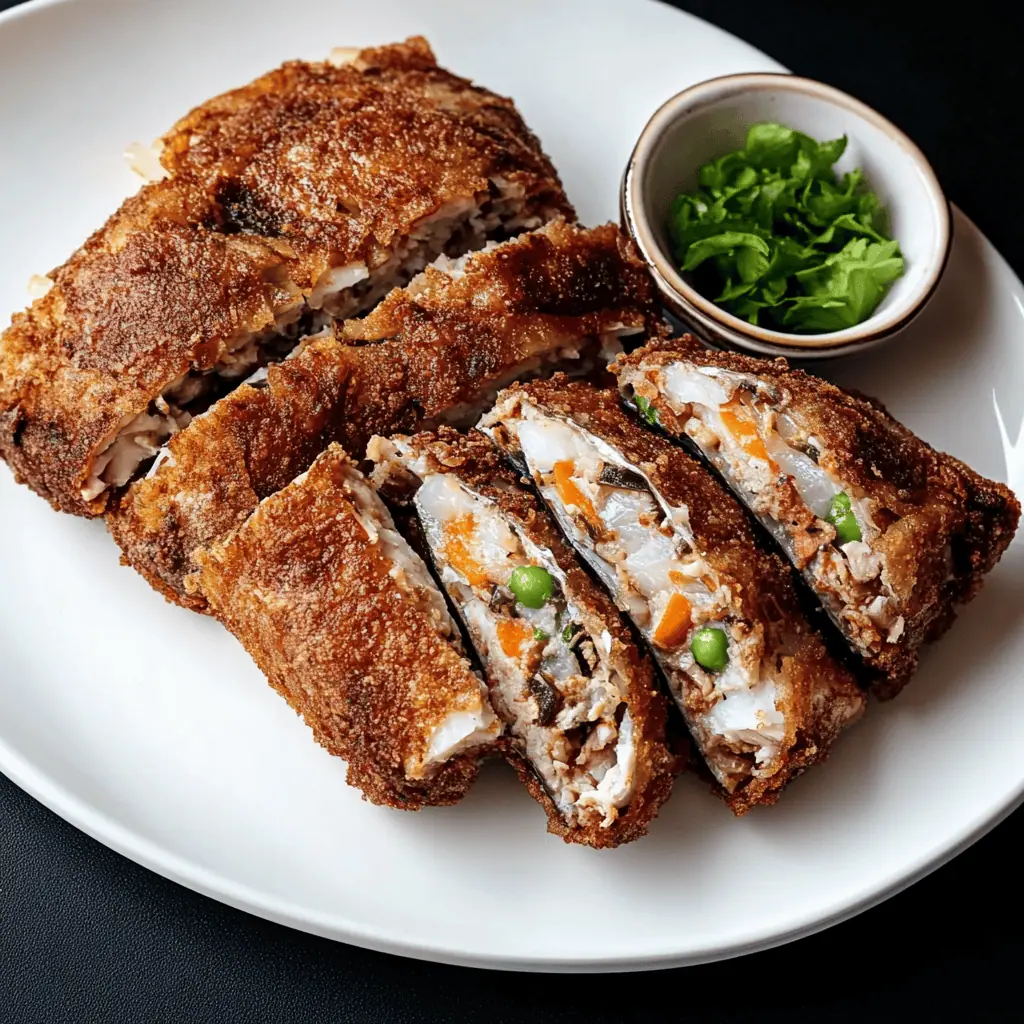






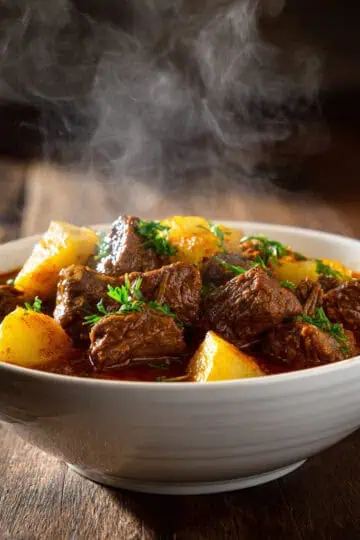

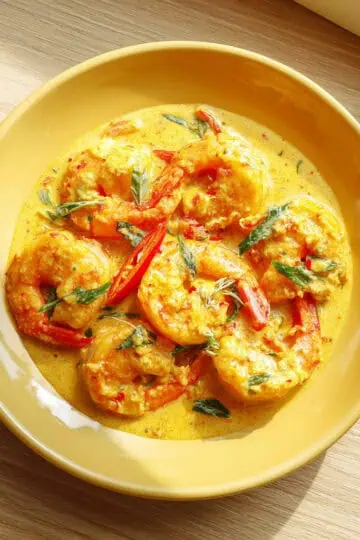
Comments
No Comments